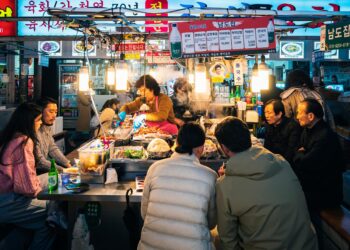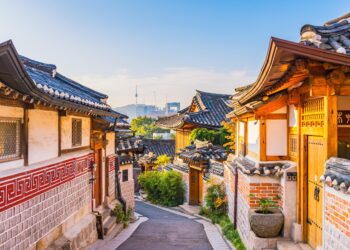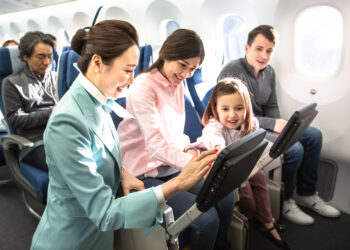
What is the South Korean concept of jeong and how can you experience it for yourself?
Here are just a few of the ways you can experience the warmth of jeong on your visit to Korea…
Some words are just untranslatable. Discovering them is one of the joys of travelling, as they often point to something so important in a culture that it needed its own term. You’ve probably learned a few already – maybe hygge from Danish, saudade from Portuguese or flâneur from French.
Whether or not they learn the word, people travelling in Korea are sure to experience jeong. Often translated as affection, closeness or love, this uniquely Korean concept encompasses all that and more. Jeong represents a bond between people, shown through acts of care and kindness. It might be between a parent and child, friends, a teacher and student, or a guest and a host. As a visitor, this sense of connection and welcome adds a depth to your time in Korea which is sure to linger long after you’re returned home.
Here are just a few of the ways you can experience the warmth of jeong on your visit to Korea.
Eat at local restaurants

In Korean culture, meals are a key way to spend quality time together. This social focus means that, when you eat at a local restaurant, you’re very likely to experience jeong.
You can expect a warm welcome from the owners, who will quickly bring you small plates of banchan, or traditional side dishes. They don’t cost extra, and can often be topped up if you ask.
Your main dishes will probably be served in the centre of the table, so everyone can share – ideal when there are so many delicious things to try. Sometimes diners will even share between tables, so don’t be surprised if you make a new best friend over sizzling samgyeopsal (grilled pork belly), a hearty jjigae (stew) or Korean fried chicken.
As you eat, be sure to reciprocate the care and kindness the restaurant staff show you. Don’t rush; slurp your noodles to show your enjoyment; and if you’d like to practise your language skills, tell them it’s delicious with a quick “mashisseoyo” (ma-shi-suh-yo).
Stay at a guesthouse

South Korea has everything from high-end hotels to laidback homestays, but if you’re keen to meet new people and connect with the local way of life, then a guesthouse is the best choice.
Korean guesthouses tend to have a mix of private and dormitory-style rooms, and common areas designed to encourage mingling. Some of them are in traditional buildings, like the beautiful hanok houses of Seoul’s Bukchon district and Jeonju’s Hanok Maeul, and have ondol-style bedrooms (with thin mattresses on heated floors).
Most guesthouses run events to build jeong between guests and hosts, ranging from casual neighbourhood tours to raucous parties. Korean barbecues are the most common, though, encouraging everyone to connect and share more about themselves over a good meal and a few glasses of soju.
Attend a craft class

Whether or not you stay in Bukchon Hanok Village, you should visit to experience a slice of traditional Korean culture in Seoul. You can do more than just admire the tiled roofs and airy courtyards – many craftspeople live or work here, offering you a chance to learn about and even make the crafts which they’ve perfected.
The Bukchon Traditional Crafts Center is a great place to start, with classes on crafts ranging from jogakbo (patchwork cloth-making) to najeonchilgi (mother-of-pearl inlay). But by going directly to specialist craft workshops, you can also learn about the artisans’ family ties to and deep love for their crafts. At Donglim Knot Workshop, you can make a bracelet or charm using maedeup decorative knot techniques which the owner’s ancestors used to make clothing for Joseon-era royals. Haneul Mulbit Workshop offers indigo dyeing experiences, showing you traditional techniques which the third-generation owner’s family revived.
Explore with a local guide

Jeong isn’t only about the connections between people. It can also be about the links we develop with places and things as we build memories with them. You can experience this by going on a tour with a local guide, sharing their favourite places and activities; B-corp-certified Withlocals is a good option for this.
Visiting the capital with a born-and-raised Seoulite like Yejin can show you aspects of the huge city which you would otherwise never know to look for. And of course, by connecting with her over her love for Seoul, you can develop jeong between you too. Many people on her tours comment on the personal care and attention she shows them, from sharing k-beauty tips to recommending places to visit elsewhere on their travels in Korea.
Travel with Korean Air

Travel with Korean Air
With jeong so central to Korean culture, it’s no surprise that it’s a guiding principle of the national airline as well. Whether you’re in economy, prestige or first class you’ll experience warm, attentive service before you take off and during your flight. In fact, you will experience an entirely Korean experience from the moment you step onboard.
Korea is known as ‘The Land of the Morning Calm’, something you will experience on board a Korean Air flight. The service is an elegant mix of efficient and effective, yet also calm and relaxed, which is a balance the team take a lot of pride in perfecting. Comfort on board is at the heart of everything and one way to express jeong is to pay attention to the needs of the other person. Whether you miss a meal and an air steward offers you a snack in case you are hungry or are a vegan and are taken care of with the thoughtful Korean vegan meals served on board. Other Korean specialities are offered too such as bibimbap and to compliment meals Korean Air pre-orders some of the best wines in advance to secure them in the best condition. It’s little wonder Korean Air has won so many Cellars in the Sky awards.
Daily flights depart from Heathrow, landing you in Seoul around 11 hours later.






















